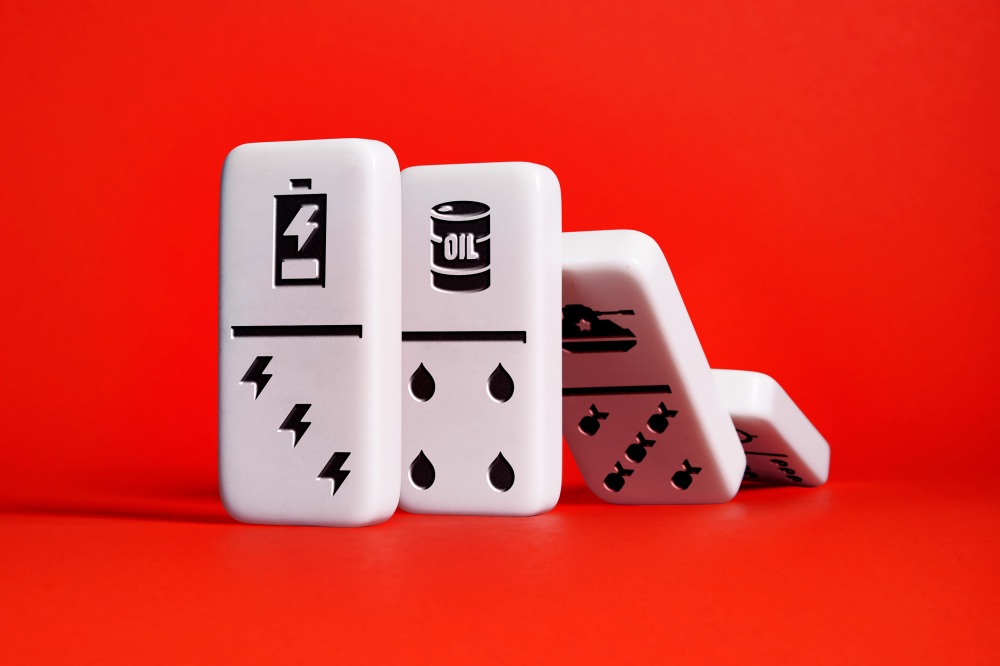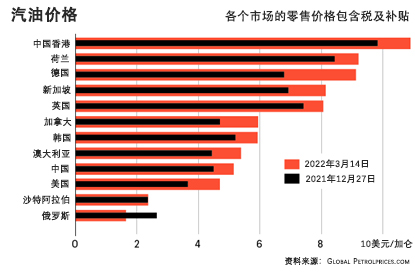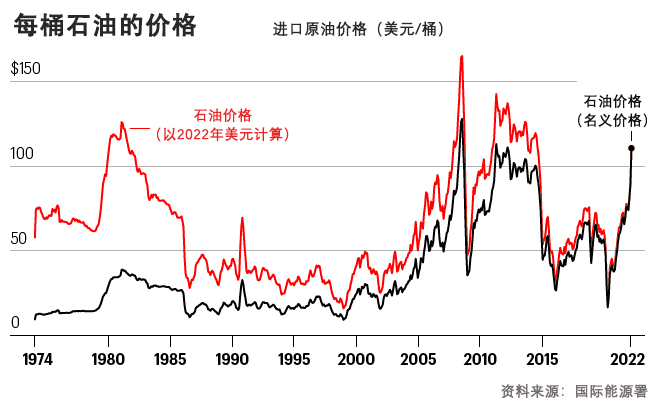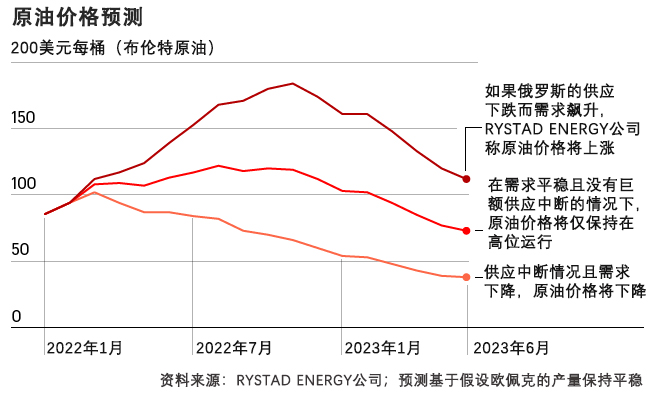
对于一家全球性企业来说,目睹人类的苦难乃至战争,往往也是其工作的常态。不过在2022年2月26日这一天,雅苒国际公司(Yara International)的首席执行官斯韦恩·托雷·霍尔塞瑟根本没有预料到,局势竟然会发展成后来的样子。
雅苒国际是一家拥有117年历史的挪威化肥公司,其业务遍及全球60多个国家。几十年来,雅苒国际在乌克兰和俄罗斯都有大量卓有成效的业务。乌克兰是一个重要的小麦出口国,而俄罗斯则向雅苒国际供应了大量钾肥和磷肥原料。而就在俄乌冲突爆发的第三天,一枚俄罗斯的导弹击中了雅苒国际在基辅的分公司总部。
由于空袭时间是清晨,因而这枚导弹并未造成人员伤亡。不过在数日后接受《财富》杂志采访时,霍尔塞瑟仍然心有余悸。他说:“当你看见挂着雅苒国际标志的办公楼被炸出一个大洞时,你就会发现,战争突然变得离你很近了。这种感觉真的很可怕。”
像很多其他行业一样,雅苒国际也从另外一个方面感受到了俄乌战争的影响——那就是不断攀升的能源价格。今年3月初的时候,随着乌克兰满目疮痍的景象连续霸占媒体头条,世界各国一片哗然,全球能源市场也陷入恐慌之中。欧盟(European Union)在2021年花了1080亿欧元(约1190亿美元)进口俄罗斯能源。但在战争爆发后,欧盟也表示在今年年底前将把对俄罗斯化石燃料的依赖度降低三分之二。
虽然欧盟最终没有完全禁止从俄罗斯进口能源,但随着英国石油(BP)、壳牌(Shell)、道达尔能源(TotalEnergies)和埃克森美孚(Exxon Mobil)等石油巨头相继宣布撤出俄罗斯,西方实际上已经实施了抵制俄罗斯能源的政策。国际能源署(International Energy Agency)警告称,从今年4月开始,“随着制裁生效和买家停止进口,俄罗斯每天可能都要砍掉300万桶的石油产量。”
受俄乌冲突影响,世界各地的石油和天然气价格全线上涨。由于能源成本飙升,3月初的时候,全欧洲的企业(包括雅苒国际在内)基本上都关闭了生产线。欧洲的天然气基准期货Title Transfer Facility的价格在3月7日创下了超过每兆瓦227欧元的纪录。霍尔塞瑟解释道:“这相当于石油价格涨到每桶600美元。我们实际上是在背着巨大的负利润在生产。”他还指出,氨肥的生产成本几乎上涨到了俄乌冲突前的20倍。
高盛集团(Goldman Sachs)的大宗商品研究主管杰夫·柯里指出:“这是1973年也就是欧佩克(OPEC)石油禁运那年以来,大宗商品市场涨幅最大的一次。”
*****
俄乌冲突也造成了欧洲自二战以来最严重的人道主义危机,目前战争已经造成了数千人死亡。马里乌波尔和哈尔科夫等城市已经成了一片废墟,超过1000万名的乌克兰难民被迫离开家园。人类在这场战争中遭受的苦难是无法用数字衡量的。
这场战争也将对全球经济产生广泛而深远的影响。石油和天然气价格的上涨只是一个开始,后续可能还会有一系列连锁反应,比如所有大宗商品价格的上涨,到时候,从面包到电动汽车,各种门类的商品可能都会涨价。

很多经济学家、政策制定者和商业领袖都警告称,如果俄乌战争继续打下去,全世界的企业和老百姓就都会受到影响。俄罗斯是全世界最大的天然气出口国,也是第二原油出口国和第三大煤炭出口国。据经合组织(OECD)预测,这场战争有可能会使今年的全球GDP增长增长率下降整整一个百分点,并将全球通胀率进一步推高2.5%。高盛集团也表示,油价每上涨10美元,就会抵消几十亿美元的经济增长。高盛的分析师指出,俄乌冲突有40%的可能性会让美国陷入衰退,而欧洲的情况就更糟了。
*****
随着夏季驾车旺季即将到来,关于油价的预测也是五花八门。巴克莱银行(Barclays)、美银证券(BofA Securities)和挪威的能源咨询与研究机构Rystad Energy均表示,一旦出现最坏情况,也就是北约(NATO)也卷入了冲突,那么作为全球石油基准的布伦特原油价格将逼近200美元。Rystad 公司的石油市场部门负责人比约纳尔·通豪根认为,这一预测“是可能的……但可能性并不是特别高”,理由是“俄罗斯的石油出口基本上已经到了‘大而不能倒’的地步”。
不过这一事实并不能够让全球能源市场放心。从今年年初到现在,布伦特原油价格已经上涨了50%以上,美国普通汽油的价格也上涨了将近30%。与此同时,石油交易员们还在密切关注未来几周的两大动向:一是俄罗斯日均出口的500万桶石油能否找到新买家——例如中国和印度。二是其他出口商,比如中东国家,会不会掉头将产能卖给欧洲和北美?但愿这种全球供应链的重新洗牌,可以让全世界避免重现20世纪70年代的那种供应链震荡。

有一件事情是肯定的:每次重大能源危机都会催生出新的经济赢家和输家。以下是我们总结的专家们的看法。
输家:
能源进口国
中东问题专家、伦敦经济学院(London School of Economics)的比较政治学教授斯特芬·赫尔托格指出:“所有主要的能源进口国都是输家。”其中首当其冲的就是欧盟。欧盟与俄罗斯能源脱钩的过程将是相当坎坷的,短期内必然导致电力和汽油价格的上涨,以及经济增长的放缓。美银证券预计,这将使欧盟今年经济增长率下降7%。

节假日出行者
2008年的石油危机已经考验过一次美国人的自驾游热情了。当时,布伦特原油价格最高涨到了146美元/桶。由于燃油价格居高不下,加上经济停滞,美国人的驾车里程连续下降了五年。通豪根说:“我们不得不接受一个事实,那就是今年暑假,我们可能不会像以前那样经常开车了。”不过环保分子可能会觉得这是一件好事情——毕竟能够减少排放。
全球穷人
2021年秋天,在联合国第26届气候大会(COP26)期间,雅苒国际的首席执行官霍尔塞瑟曾经警告道,能源价格的飙升有可能导致全球粮食危机。现在俄乌战争刚刚打了一个月,局势就已经超出了他的预期,小麦、玉米和大麦价格全线飙升。霍尔塞瑟表示,俄乌战争及其对全球能源价格的影响,很可能会让全世界在帮助数亿人脱贫和摆脱饥饿上的努力化为乌有。他和联合国世界粮食计划署(United Nations World Food Programme)的执行主任大卫·比斯利的看法一样,认为现在的局势简直是“灾上加灾”。

赢家:
少数出口国
新时期的石油地缘政治可以用“他人看跌我看涨”来形容。委内瑞拉的总统尼古拉斯·马杜罗等人应该就是这么想的。马杜罗并未放弃对普京的支持。但是在俄乌战争开打后,马杜罗这么多年来头一次会见了一个美国代表团,要谈的自然是能源问题。中东问题专家、伦敦经济学院比较政治学教授斯蒂芬·赫尔托格认为:“从短期来看,这对石油出口国是一个利好消息,包括伊朗和委内瑞拉,都有可能通过由美国软化或取消制裁的方式,向市场投放更多的石油。”《沙特公司》(Saudi, Inc.)一书的作者艾伦·沃尔德也认为,随着油价高涨,“伊朗也比过去多赚了很多钱。”伊朗还可以利用目前的经济形势,在谈判中采取强硬态度,以争取暂缓制裁,并且全面重返石油出口市场。
煤炭、页岩气与液化天然气
德国等欧洲国家对高污染的煤炭的态度也有了180度的转变。今年3月,作为欧元区最大经济体的德国呼吁欧洲应该建立煤炭储备以解决电力问题。未来几年,欧洲的另一个赢家很可能将是液化天然气。美银证券认为,随着欧洲推动进口液化天然气作为俄罗斯天然气的替代品,欧盟很可能将成为全球增长最快的液化天然气市场。而在大西洋对岸的美国,页岩气将再次称王。拜登政府希望美国页岩气生产商提高产量,以顶上日均70万桶的俄罗斯原油的缺口。而今年3月,美国的页岩气生产商也确实加大了钻井力度,只不过开采活动仍然低于新冠疫情前的水平。
可再生能源
在短期内,一些国家大干快上煤炭和页岩油的做法,或许会让一些社会责任投资者感到恐慌。但从长期看来,情况还是乐观的。俄乌战争导致的化石燃料价格上涨,只会进一步碳捕获与存储(CCS)和绿色氢能等净零排放技术的价值。据Rystad Energy公司预测,CCS技术的投资额将在未来三年翻四番,达到500亿美元。欧盟也制订了一个雄心勃勃的计划,要在2030年前用清洁氢能取代近半数俄罗斯天然气。拜登政府也承诺10年内将投入95亿美元以促进氢能发展。
在家办公一族
今年3月,国际能源署发布了一份关于如何将全球日均石油消费量迅速降低270万桶的十点计划。第一点就是每周在家办公三天,对于视频会议能够搞定的事情,尽量不要出差。新冠疫情发展到现在,我们对这一套流程应该都很熟悉了。(财富中文网)
本文另一版本登载于《财富》杂志2022年4/5月刊,标题为《石油的国际新秩序》(Oil's New World Order)。
译者:朴成奎
对于一家全球性企业来说,目睹人类的苦难乃至战争,往往也是其工作的常态。不过在2022年2月26日这一天,雅苒国际公司(Yara International)的首席执行官斯韦恩·托雷·霍尔塞瑟根本没有预料到,局势竟然会发展成后来的样子。
雅苒国际是一家拥有117年历史的挪威化肥公司,其业务遍及全球60多个国家。几十年来,雅苒国际在乌克兰和俄罗斯都有大量卓有成效的业务。乌克兰是一个重要的小麦出口国,而俄罗斯则向雅苒国际供应了大量钾肥和磷肥原料。而就在俄乌冲突爆发的第三天,一枚俄罗斯的导弹击中了雅苒国际在基辅的分公司总部。
由于空袭时间是清晨,因而这枚导弹并未造成人员伤亡。不过在数日后接受《财富》杂志采访时,霍尔塞瑟仍然心有余悸。他说:“当你看见挂着雅苒国际标志的办公楼被炸出一个大洞时,你就会发现,战争突然变得离你很近了。这种感觉真的很可怕。”
像很多其他行业一样,雅苒国际也从另外一个方面感受到了俄乌战争的影响——那就是不断攀升的能源价格。今年3月初的时候,随着乌克兰满目疮痍的景象连续霸占媒体头条,世界各国一片哗然,全球能源市场也陷入恐慌之中。欧盟(European Union)在2021年花了1080亿欧元(约1190亿美元)进口俄罗斯能源。但在战争爆发后,欧盟也表示在今年年底前将把对俄罗斯化石燃料的依赖度降低三分之二。
虽然欧盟最终没有完全禁止从俄罗斯进口能源,但随着英国石油(BP)、壳牌(Shell)、道达尔能源(TotalEnergies)和埃克森美孚(Exxon Mobil)等石油巨头相继宣布撤出俄罗斯,西方实际上已经实施了抵制俄罗斯能源的政策。国际能源署(International Energy Agency)警告称,从今年4月开始,“随着制裁生效和买家停止进口,俄罗斯每天可能都要砍掉300万桶的石油产量。”
受俄乌冲突影响,世界各地的石油和天然气价格全线上涨。由于能源成本飙升,3月初的时候,全欧洲的企业(包括雅苒国际在内)基本上都关闭了生产线。欧洲的天然气基准期货Title Transfer Facility的价格在3月7日创下了超过每兆瓦227欧元的纪录。霍尔塞瑟解释道:“这相当于石油价格涨到每桶600美元。我们实际上是在背着巨大的负利润在生产。”他还指出,氨肥的生产成本几乎上涨到了俄乌冲突前的20倍。
高盛集团(Goldman Sachs)的大宗商品研究主管杰夫·柯里指出:“这是1973年也就是欧佩克(OPEC)石油禁运那年以来,大宗商品市场涨幅最大的一次。”
*****
俄乌冲突也造成了欧洲自二战以来最严重的人道主义危机,目前战争已经造成了数千人死亡。马里乌波尔和哈尔科夫等城市已经成了一片废墟,超过1000万名的乌克兰难民被迫离开家园。人类在这场战争中遭受的苦难是无法用数字衡量的。
这场战争也将对全球经济产生广泛而深远的影响。石油和天然气价格的上涨只是一个开始,后续可能还会有一系列连锁反应,比如所有大宗商品价格的上涨,到时候,从面包到电动汽车,各种门类的商品可能都会涨价。
很多经济学家、政策制定者和商业领袖都警告称,如果俄乌战争继续打下去,全世界的企业和老百姓就都会受到影响。俄罗斯是全世界最大的天然气出口国,也是第二原油出口国和第三大煤炭出口国。据经合组织(OECD)预测,这场战争有可能会使今年的全球GDP增长增长率下降整整一个百分点,并将全球通胀率进一步推高2.5%。高盛集团也表示,油价每上涨10美元,就会抵消几十亿美元的经济增长。高盛的分析师指出,俄乌冲突有40%的可能性会让美国陷入衰退,而欧洲的情况就更糟了。
*****
随着夏季驾车旺季即将到来,关于油价的预测也是五花八门。巴克莱银行(Barclays)、美银证券(BofA Securities)和挪威的能源咨询与研究机构Rystad Energy均表示,一旦出现最坏情况,也就是北约(NATO)也卷入了冲突,那么作为全球石油基准的布伦特原油价格将逼近200美元。Rystad 公司的石油市场部门负责人比约纳尔·通豪根认为,这一预测“是可能的……但可能性并不是特别高”,理由是“俄罗斯的石油出口基本上已经到了‘大而不能倒’的地步”。
不过这一事实并不能够让全球能源市场放心。从今年年初到现在,布伦特原油价格已经上涨了50%以上,美国普通汽油的价格也上涨了将近30%。与此同时,石油交易员们还在密切关注未来几周的两大动向:一是俄罗斯日均出口的500万桶石油能否找到新买家——例如中国和印度。二是其他出口商,比如中东国家,会不会掉头将产能卖给欧洲和北美?但愿这种全球供应链的重新洗牌,可以让全世界避免重现20世纪70年代的那种供应链震荡。
有一件事情是肯定的:每次重大能源危机都会催生出新的经济赢家和输家。以下是我们总结的专家们的看法。
输家:
能源进口国
中东问题专家、伦敦经济学院(London School of Economics)的比较政治学教授斯特芬·赫尔托格指出:“所有主要的能源进口国都是输家。”其中首当其冲的就是欧盟。欧盟与俄罗斯能源脱钩的过程将是相当坎坷的,短期内必然导致电力和汽油价格的上涨,以及经济增长的放缓。美银证券预计,这将使欧盟今年经济增长率下降7%。
节假日出行者
2008年的石油危机已经考验过一次美国人的自驾游热情了。当时,布伦特原油价格最高涨到了146美元/桶。由于燃油价格居高不下,加上经济停滞,美国人的驾车里程连续下降了五年。通豪根说:“我们不得不接受一个事实,那就是今年暑假,我们可能不会像以前那样经常开车了。”不过环保分子可能会觉得这是一件好事情——毕竟能够减少排放。
全球穷人
2021年秋天,在联合国第26届气候大会(COP26)期间,雅苒国际的首席执行官霍尔塞瑟曾经警告道,能源价格的飙升有可能导致全球粮食危机。现在俄乌战争刚刚打了一个月,局势就已经超出了他的预期,小麦、玉米和大麦价格全线飙升。霍尔塞瑟表示,俄乌战争及其对全球能源价格的影响,很可能会让全世界在帮助数亿人脱贫和摆脱饥饿上的努力化为乌有。他和联合国世界粮食计划署(United Nations World Food Programme)的执行主任大卫·比斯利的看法一样,认为现在的局势简直是“灾上加灾”。
赢家:
少数出口国
新时期的石油地缘政治可以用“他人看跌我看涨”来形容。委内瑞拉的总统尼古拉斯·马杜罗等人应该就是这么想的。马杜罗并未放弃对普京的支持。但是在俄乌战争开打后,马杜罗这么多年来头一次会见了一个美国代表团,要谈的自然是能源问题。中东问题专家、伦敦经济学院比较政治学教授斯蒂芬·赫尔托格认为:“从短期来看,这对石油出口国是一个利好消息,包括伊朗和委内瑞拉,都有可能通过由美国软化或取消制裁的方式,向市场投放更多的石油。”《沙特公司》(Saudi, Inc.)一书的作者艾伦·沃尔德也认为,随着油价高涨,“伊朗也比过去多赚了很多钱。”伊朗还可以利用目前的经济形势,在谈判中采取强硬态度,以争取暂缓制裁,并且全面重返石油出口市场。
煤炭、页岩气与液化天然气
德国等欧洲国家对高污染的煤炭的态度也有了180度的转变。今年3月,作为欧元区最大经济体的德国呼吁欧洲应该建立煤炭储备以解决电力问题。未来几年,欧洲的另一个赢家很可能将是液化天然气。美银证券认为,随着欧洲推动进口液化天然气作为俄罗斯天然气的替代品,欧盟很可能将成为全球增长最快的液化天然气市场。而在大西洋对岸的美国,页岩气将再次称王。拜登政府希望美国页岩气生产商提高产量,以顶上日均70万桶的俄罗斯原油的缺口。而今年3月,美国的页岩气生产商也确实加大了钻井力度,只不过开采活动仍然低于新冠疫情前的水平。
可再生能源
在短期内,一些国家大干快上煤炭和页岩油的做法,或许会让一些社会责任投资者感到恐慌。但从长期看来,情况还是乐观的。俄乌战争导致的化石燃料价格上涨,只会进一步碳捕获与存储(CCS)和绿色氢能等净零排放技术的价值。据Rystad Energy公司预测,CCS技术的投资额将在未来三年翻四番,达到500亿美元。欧盟也制订了一个雄心勃勃的计划,要在2030年前用清洁氢能取代近半数俄罗斯天然气。拜登政府也承诺10年内将投入95亿美元以促进氢能发展。
在家办公一族
今年3月,国际能源署发布了一份关于如何将全球日均石油消费量迅速降低270万桶的十点计划。第一点就是每周在家办公三天,对于视频会议能够搞定的事情,尽量不要出差。新冠疫情发展到现在,我们对这一套流程应该都很熟悉了。(财富中文网)
本文另一版本登载于《财富》杂志2022年4/5月刊,标题为《石油的国际新秩序》(Oil's New World Order)。
译者:朴成奎
For a global business that works with miners and farmers, witnessing the ravages of human suffering and even war is too often part of the job. Still, nothing could quite prepare Yara International CEO Svein Tore Holsether for what he woke to on Feb. 26—or, for that matter, what would come next.
Yara, a 117-year-old Norwegian fertilizer giant, operates in more than 60 countries. For decades, Yara has had a large and fruitful presence in both Ukraine, a major wheat exporter, and in Russia, a key supplier of the potash and phosphate needed in Yara’s fertilizer production. On day three of Russia’s invasion of Ukraine, a Russian missile blasted into the headquarters of Yara Ukraine in Kyiv.
No Yara employees were injured in the early-morning air strike, but Holsether was still shaken days later when he spoke to Fortune. War, he said, “becomes quite close when you see the office building, with the Yara sign on it, and a big hole. That’s really scary.”
Like companies in a wide range of industries, Yara felt the impact of the invasion in another way, too: rising energy prices. As Russian missiles flattened Ukrainian apartment blocks, hospitals, and businesses in early March, shock gripped the world’s capitals and panic tore through global energy markets. Incensed, the European Union, which spent €108 billion ($119 billion) on Russian energy imports last year, vowed to slash by two-thirds its dependence on Russian fossil fuels by year-end.
Plans for an outright EU ban on Russian oil eventually stalled. But oil giants BP, Shell, TotalEnergies, and Exxon Mobil effectively created an embargo anyhow when they announced plans to pull out of Russia, ending decades of investment. The International Energy Agency (IEA) now warns that, beginning in April, “3 [million barrels per day] of Russian oil output could be shut in as sanctions take hold and buyers shun exports.”
These tectonic shifts are creating a supply crunch, pushing up the price of oil and natural gas everywhere. Businesses across Europe, Yara included, shut down operations in early March to save money as energy bills skyrocketed: Europe’s natural gas benchmark, the Title Transfer Facility, spiked to a record high above €227 per megawatt on March 7 before correcting. “That’s an oil price equivalent of $600 per barrel. We were running at huge negative margins,” Holsether explains, adding production costs for ammonia rose nearly 20-fold on prewar levels.
Says Jeff Currie, head of commodity research at Goldman Sachs: “This is the biggest upheaval for commodities markets since 1973”—the year of the OPEC oil embargo.
*****
The Russian invasion of Ukraine has precipitated Europe’s worst humanitarian crisis since World War II. Thousands are dead already. Cities like Mariupol and Kharkiv lie in ruins. More than 10 million Ukrainian refugees have been forced from their homes. The scale of human suffering is incalculable.
Vladimir Putin’s war will also have a wide-ranging and long-lasting impact on the global economy. And the surge in oil and gas prices is just the start. The ripple effects are likely to push up the cost of all commodities, making products ranging from bread to electric vehicles more expensive.
Economists, policymakers, and business leaders warn that as long as Russia—the world’s biggest natural gas exporter, as well as its No. 2 crude and No. 3 coal exporter—keeps bombing Ukraine, businesses and homeowners the world over will feel it. The war could whack a full percentage point off global GDP growth this year, the OECD calculates, and push the global inflation rate up by a further 2.5%. Goldman Sachs, meanwhile, says every $10 hike in oil prices wipes out billions in economic growth. Its analysts say there’s a 40% chance the Ukraine invasion will sink the U.S. into recession. The odds are even worse for Europe.
*****
Heading into the summer driving season, forecasts for oil prices are all over the place. Barclays, BofA Securities, and Rystad Energy, the Oslo-based energy consultancy and research firm, all say their worst-case scenario—think NATO being drawn into the bloody conflict—is Brent crude, the global benchmark, nearing $200. That upper-range assessment is in the “possible … but not particularly likely” category, says Bjørnar Tonhaugen, head of oil markets at Rystad. The reason: “Russia’s oil exports are basically too big to fail,” he says.
That fact is hardly reassuring the global energy markets. Brent is up more than 50% so far in 2022, and the price of regular gasoline in the U.S. has risen nearly 30%. Oil traders, meanwhile, are watching for two big developments in the coming weeks: Will Russia’s daily exports of 5 million barrels find new buyers in, say, India and China? And, if so, will other exporters—the Middle East, maybe—turn around and begin to sell to Europe and North America? Such a global recalibration of supplies, it’s hoped, would stabilize prices and save the planet from a 1970s-style supply shock.
One thing is for sure: Every major energy crisis yields new economic winners and losers. Here’s what the experts we surveyed are expecting.
The losers:
Importing nations
“All major energy importers are losers,” says Steffen Hertog, a Middle East expert and professor of comparative politics at the London School of Economics. For Exhibit A, look no further than the EU. Its commitment to weaning itself off Russian energy will be a rocky process that in the short term will mean higher electricity and petrol prices, and lower growth. Count on a 0.7% hit this year to growth, says BofA.
Holiday travelers
The 2008 oil crisis, in which Brent hit a high of $146 per barrel, tested Americans’ love affair with the automobile. As fuel prices remained elevated and the economy sputtered, the number of miles Americans drove in their cars fell for five straight years. “We just have to accept the fact that we won’t be driving as much in our cars, on vacation, this summer,” Tonhaugen figures. On the flip side: Climate hawks would cheer the reduced emissions.
The global poor
Last autumn, on the sidelines of the COP26 climate summit, Yara CEO Holsether warned the world that spiking energy prices could lead to a global food crisis. One month into Russia’s invasion of Ukraine, the situation is beyond his worst fears with wheat, corn, and barley prices soaring. The war, and its impact on global energy prices, could undo the progress the world’s made in lifting hundreds of millions out of hunger and poverty, Holsether warns. He calls it the “catastrophe on top of the catastrophe,” echoing the words of David Beasley, executive director of the United Nations World Food Programme.
The winners:
Rogue exporting nations
The new geopolitics of oil can best be described as “down-is-up,” a policy shift happily welcomed by the likes of Venezuela’s President Nicolás Maduro. He hasn’t backed down in his support of Putin. Still, for the first time in years, Maduro met with a U.S. delegation in the early days of the war to talk, yes, energy. “It is definitely good news in the short run for oil exporters, including ones that might be able to put additional oil on to the market through softened or abrogated U.S. sanctions like Iran and Venezuela,” Hertog reckons. As for Iran, at these oil prices, “it’s making a lot more money than it was before,” points out Ellen Wald, an energy consultant and author of Saudi, Inc. Iran could use the current economics to play hardball as it negotiates to win a reprieve from sanctions, and fully return to the export market.
Coal, shale, and LNG
Germany, among others in Europe, has pulled an about-face on dirty coal. In March, the eurozone’s biggest economy called for the creation of strategic coal reserves to keep the lights on. Another winner in Europe in the coming years: liquefied natural gas. Europe’s push to import LNG as a Russian gas substitute will make the EU the world’s fastest-growing LNG market, BofA Securities calculates. Across the Atlantic, fracking could once again be king. The Biden administration wants U.S. shale producers to boost production to meet the shortfall of the 700,000 barrels per day of Russian crude that’s now banned. In March, shale producers responded by drilling more wells, though rig activity remains below pre-pandemic levels.
Renewables
In the short run, ESG investors will look in horror on governments cozying up to shale and coal. But longer term, things are looking sunnier. The war, and the resulting surge in fossil fuel prices, is already proving to be an accelerator for such net-zero technologies as carbon capture and storage (CCS) and green hydrogen. Rystad forecasts CCS investments will quadruple over the next three years to top $50 billion. And the EU has set an ambitious 2030 target to replace nearly half of Russian gas with clean hydrogen. The Biden administration, meanwhile, has committed $9.5 billion to boost hydrogen power this decade.
WFH warriors
In March, the IEA published a 10-point plan to spell out how the world could quickly cut 2.7 million barrels of oil from its daily consumption. Top of the list? Work from home three days a week, and forgo business travel when a Zoom call will do. That’s something we all know how to do by now.
This article appears in the April/May 2022 issue of Fortune with the headline, “Oil's New World Order.”






